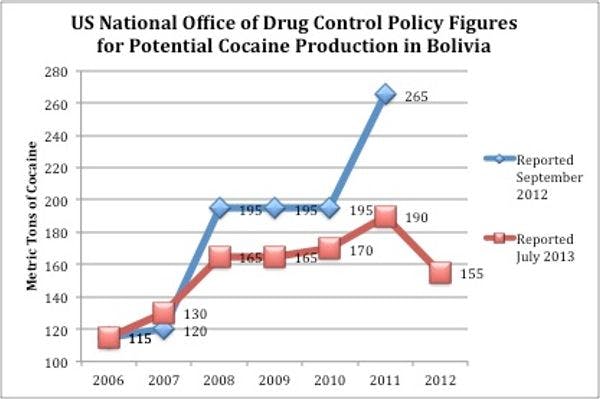La ONDCP reduce drásticamente las estimaciones de producción potencial de cocaína en Bolivia
En el último informe de la Oficina de Política Nacional de Control de Drogas de los Estados Unidos (ONDCP) se inflaron las cifras de producción de cocaína en Bolivia, con lo que se alteraron las estadísticas regionales.
Más información, en inglés, está disponible abajo.
Suscríbase a las Alertas mensuales del IDPC para recibir información sobre cuestiones relacionadas con políticas sobre drogas.
On July 9, the US Office of National Drug Control Policy (ONDCP) published its estimates of potential cocaine production in the Andes, citing a significant region-wide decrease from 2011 to 2012. The largest reduction reported occurred in Bolivia: -18%, compared to -5% in Peru and -8% in Colombia. Yet the ONDCP attributed the regional reduction to the “strengthened U.S.-Colombia partnership forged over the past decade and the increased commitment to counternarcotics cooperation and citizen security from President Ollanta Humala and the Government of Peru” as well as other developments in those two countries. There was no mention of Bolivia.
Unexplained Change in Figures
Although they failed to provide any explanation, the same ONDCP press release reported Bolivia’s potential cocaine production for 2011 at 190 metric tons—instead of the whopping 265 metric tons for 2011 reported by the same office a year earlier. The estimates drew harsh criticism from the international community, as well as AIN and the Washington Office on Latin America, for inflating figures for Bolivia and downplaying Colombia’s cocaine production. This is especially hard to swallow considering Colombia’s coca crop is considerably larger, and both countries employ similar processing methods.
Using the original figure, the decline in cocaine production from 2011-2012 would be -41% —a dramatic change. In fact, the ONDCP webpage retroactively reduced the previous five years of potential cocaine production figures from those published on the same page in September 2012.
Read here the full article.
Keep up-to-date with drug policy developments by subscribing to the IDPC Monthly Alert.
